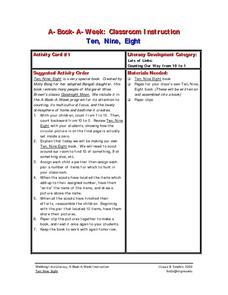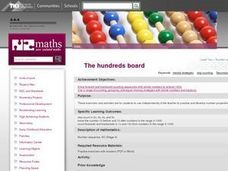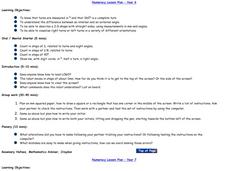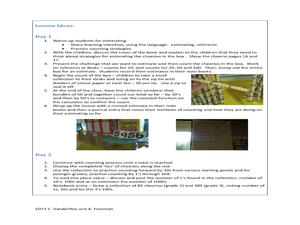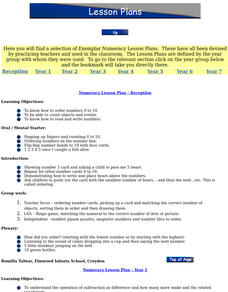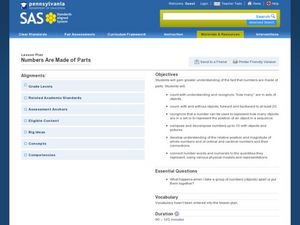Curated OER
Count Back by 2
In this counting backwards worksheet, students count back by 2 starting at 3 different sets of numbers. A reference website for additional resources is given.
Alabama Learning Exchange
Wheels All Around
Budding mathematicians explore the concept of skip counting. They practice skip counting as they use it to determine the number of wheels that come to school at 3 different times throughout the day. They also create a data graph to show...
Math Learning Center
Grade 1 Assessments and Scoring Checklists, Common Core State Standards
Track your learners' progress in addition, subtraction, counting, and interpreting word problems with a series of assessments. The packet includes scoresheets to note learners' strengths and weaknesses as you address each skill.
Curated OER
Identifying Patterns
Find the pattern! Eighteen number sequences challenge scholars to identify and complete the pattern, adding at least four digits to the given numbers. All the sequences here involve skip counting by various single-digit numbers,...
Curated OER
Counting Back by Tens
In this counting backwards worksheet, 2nd graders study and review a chart to assist them in solving 4 subtraction math problems.
Math Learning Center
Second Grade Assessments and Scoring Checklists, Common Core State Standards
How are your second graders progressing in their math skills? Find out with a series of math assessment activities. With baseline assessment score sheets for each skill, you can track how well your kids are adding, subtracting, telling...
Primary National Strategy
Ordering and Counting
Are you in need of a 5-day unit intended to teach little learners how to count to 20? This is a well-structured complete set of lessons which employ a variety of methods to instruct learners about various ways to count from 1 to 20. They...
Curated OER
Ten, Nine, Eight
Students engage in the reading of several stories that focus upon number identification and counting. They read the story together as a class and focus upon identifying the correct number on each page. Then students should practice...
Education Creations
Morning Math
Jump-start your morning mathematicians with this set of warm ups! Consider simply projecting the problem of the day for the entire class and having them complete the work in individual notebooks or with a partner. Concepts include...
Curated OER
Count Forward and Backwards in Halves
In this counting worksheet, students count forward and backwards in halves as directed by given numbers. An answer key and website reference are given.
Curated OER
Late-In-The-Year Counting
Students practice forward and backward counting. In this counting lesson, students calculate how many objects in a bag by counting forward and then count backward to check.
Curated OER
Count From 10 to 0 Backwards
In this math instructional activity, students count from 10 to 0 backwards, placing the numbers inside bubbles in an undersea picture. There are some hints provided.
Curated OER
Number Sequencing Packet
This dynamic 4-page packets challenges students to practice number sequencing. The sequences get progressively more difficult. Your class must count by ones, backwards, by twos, and by threes. Students can complete this packet as an...
Curated OER
The Binary Counter Circuit
Students count from 0-99 using the binary number system. In this algebra activity, students problem solve by working with faulty circuits and applying their knowledge f Binary Numbers. They work in team to create a solution.
Curated OER
Anchoring Numbers to Five and Ten
Students complete activities to relate numbers to each other. In this number connection lesson plan, students count number sets, count forward and backward, and complete other number recognition activities to learn how numbers are related.
Curated OER
The Hundreds Board
Students explore the concept of multiples and use a hundreds board to add numbers and then graph them. Afterward, they use the sieve of Eratosthenes to identify prime numbers and discover how numbers change when you add or subtract by ten.
Curated OER
Numeracy Lesson Plans
Learners complete a series of lesson plans dealing with numbers, counting, and ordering. In this numbers lesson plan, students identify numbers, identify number patterns, count forwards and backwards, and more.
Curated OER
Multiplication: Doubling and Halving
Intended for summer school, this unit review covers basic multiplication through doubling and halving, division, fraction to decimal conversion, and word problems involving decimal numbers. Use it to warm up the class, review concepts,...
Curated OER
Book Title: Great Estimations
Explore estimation with your math class. They will estimate how many Cheerios are in a box. Then count and group 50 Cheerios on a twist tie and attach groups to represent hundreds. They then discuss and practice skip counting and revise...
Curated OER
Numeracy Lesson Plan: Reception
Students examine number sense by participating in identification activities. For this number value lesson, students practice counting from 1-10, identifying number flash cards, reading clocks and multiplying basic numbers. Students...
Curated OER
Learning 8 - Write the Word
Two, four, six, eight! Youngsters focus on the number eight, starting with spelling its word form. First, they trace it and then print it once on their own. Next, scholars incorporate counting forward and backward by filling in numbers...
Pennsylvania Department of Education
Numbers Are Made of Parts
Children play with barnyard animal cards to practice composing and decomposing numbers. With their "secret number" of animal cards in a cup, they shake and spill them onto a barn story board, counting how many animals fall in the barn...
Curated OER
Money Matters
Students practice spending money by completing math word sentences. In this economics lesson, students utilize problem solving strategies to complete word problems written on the board involving making purchases with money. Students...
Curated OER
My Time!
Learners explore how to tell time by looking at their daily schedule. Everyone's days start out the same (with school), but what does each learner do after school? How do they spend their time?









